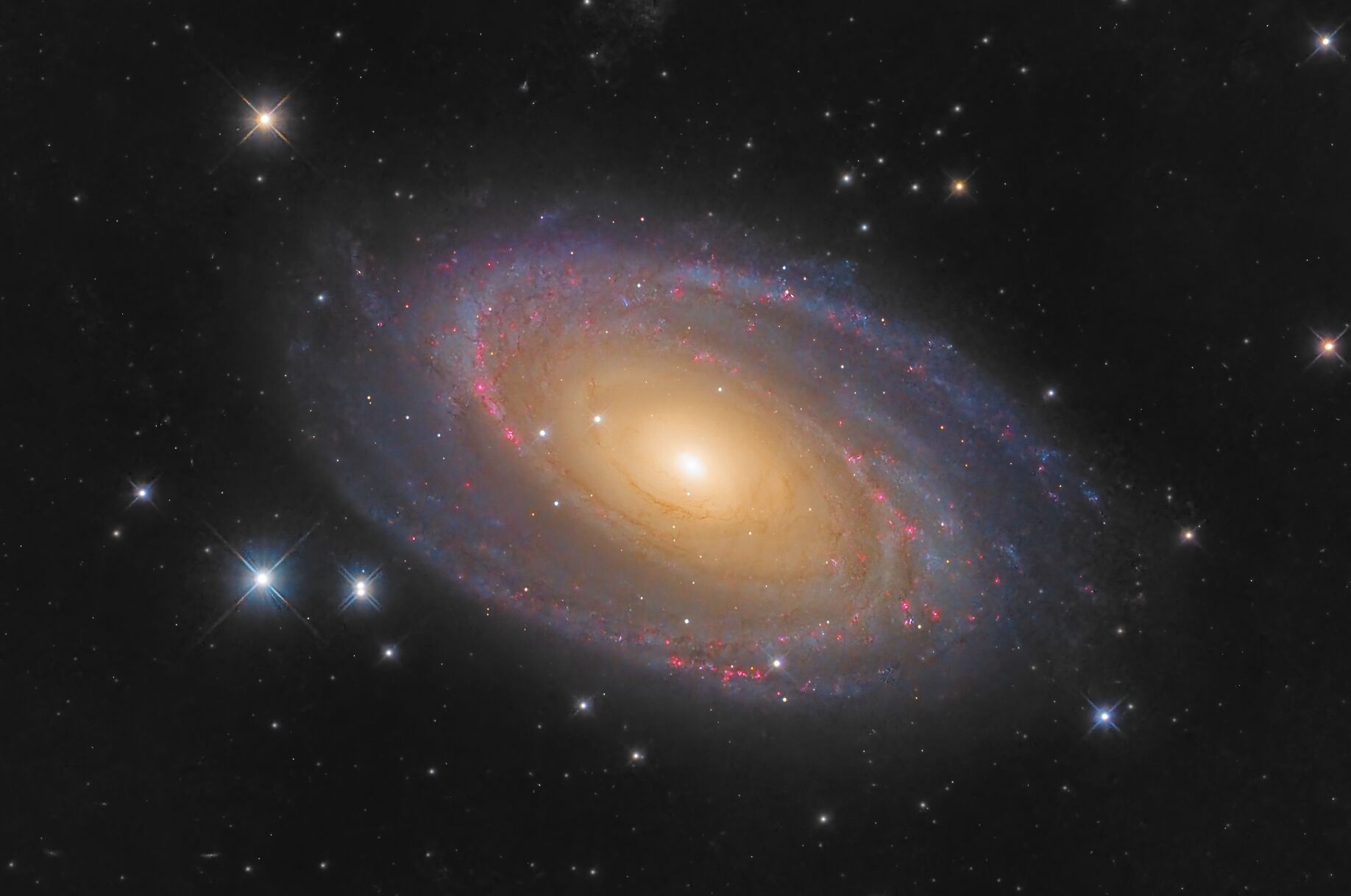The result of 36 hours of total exposure time!
Arriving at this finished photo was quite the journey! It took 36 hours of total exposure time and is made up of a 1x2 mosaic (one panel for Messier 81 and one for Messier 82).
These two neighboring galaxies belong to the M81 Group, which got its name from Messier 81 (the big galaxy on the left hand side in the photo). They are located roughly 12 Million Light years from earth in the constellation of Ursae Majoris (Big Bear).
Messier 81
Messier 81 (also known as “The Bodes Galaxy”) is one of the most prominent spiral galaxies in the northern hemishpere. It features two very prominent spiral arms with a very bright core. The galaxy is estimated to be the home to roughly 250 billion star systems.
The galaxy features a supermassive black hole in the center, which to todays knowledge, weighs around 70 Million star masses, that’s around 15 times as massive as the the black hole in the center of the Milkyway! This supermassive black hole causes the galaxy to have a very dense and bright central bulge (much brighter and bigger than the one from our Milkyway), in which a lot of red and very old stars can be found.
It is theorised, that the main population of stars populating this galaxy have been formed around 600 Million years ago. These stars are formed in hot / ionising gas regions which shine in a bright red light (Hydrogen-Alpha line). By taking narrowband H-alpha photos and overlaying it with the wideband color photo, these star forming regions were enhanced in contrast and can be seen in the image as red dots inside the galaxy’s arms.

Messier 82
The weird looking shape of this galaxy also gave this galaxy the rather unique name Cigar Galaxy. This galaxy is categorized as a starburst galaxy, meaning it is undergoing an exceptionally strong phase of star formation.
It is currently theorized that this high rate of star formation was triggered by gravitational interactions with its neighbor Messier 81 (see above). Because of this Messier 82 is a very bright galaxy with its central region beeing 100 times mores luminous than the central region of the Milkyway.
The reddish looking clouds coming out perpendicular to its main structure show the strong hydrogen filament of the galaxy (red corresponds to hydrogen-alpha spectral line).
Up until 2005 Messier 82 was thought to be an irregular galaxy when observatories discovered that it actually has two symmetrical spiral arms in near-infrared images. Since we have an almost perfectly edge-on view onto the galaxy, detecting structures inside the galaxy proofs very difficult.
Messier 82 has a diameter of around 41'000 light years.

Other background galaxies in the image
A (incomplete) list of all the other galaxies in this photo:
| Name | Luminosity [mag] | Distance form earth |
|---|---|---|
| PGC2724146 | 18.79 | Unknown |
| PGC2726822 | 18.04 | ~800 Million Light years (z) |
| PGC28757 | 14.10 | ~12.3 Million Light years |
| PGC28848 | 15.50 | ~50 Million Light years (z) |
| PGC2730409 | Unknown | Unknown |
| PGC3097961 | Unkown | Unknown |
| PGC2731294 | 20.06 | Uknown |
| PGC2732720 | Unkown | Unkown |
| PGC2732720 | Unknown | Unknown |
| PGC2733060 | 18.14 | Unknown |
| PGC28529 | 18.89 | 13.6 Million Light years |
| PGC28505 | 16.72 | ~520 Million Light years (z) |
| PGC2730709 | 20.20 | Unknown |
| PGC2730379 | 18.96 | ~1500 Million Light years (z) |
| PGC2732102 | Unknown | Unknown |
| PGC2732338 | 17.80 | ~2700 Million Light years (z) |
| PGC3086325 | 19.29 | ~300 Million light years (z) |
Data source: SIMBAD (https://simbad.cds.unistra.fr/simbad)
The distance values with (z) were calculated through measured redshift using the expanding universe and Hubble’s
constant.
Many more small / distant galaxies are visible in the image if one looks for them in the background of the photo.
